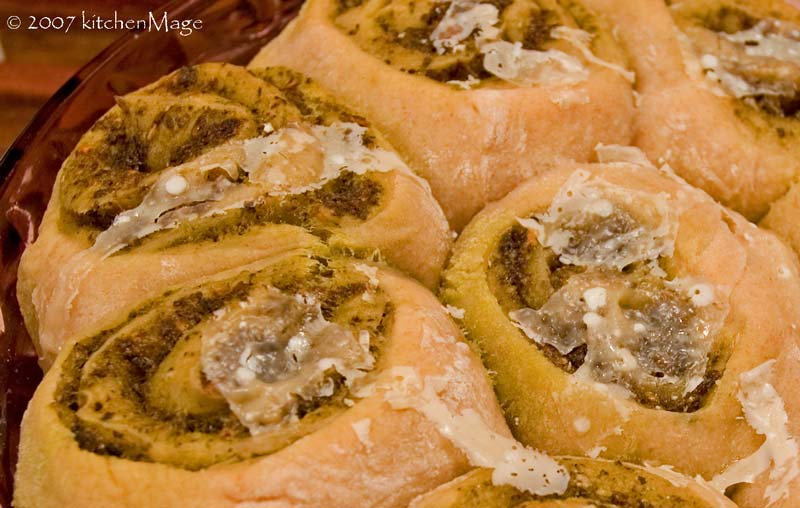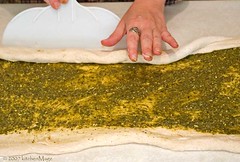Beth: Summer Breads - Pesto Rolls
Around my place, summer means casual food that can be grabbed on the run, or taken to impromptu parties and late night bonfires. Like tomorrow night's solstice bonfire, or tonight's impromptu birthday celebration. (Not that the birthday is impromptu, but the celebration is.)
Summer is also when my herbMage aspect emerges in full bloom to fall upon the bounty of seasonal herbs, especially basil. Don't get me wrong, I love most herbs but I have a particular soft spot for basil. I am guessing that many of you share this particular fondness; basil seems to always have plenty of dates for summer parties.
These rolls are one of my favorite summer breads. Easy to make and infinitely variable, they don't need to be sliced or buttered, making them perfect for those casual summer picnics and parties where cutlery is superfluous.
The dough is relatively simple, although it does use a starter, and the extra few minutes it takes to fill, roll, and slice into rolls is well worth it for the payoff. I usually make my first batch of these babies in early June and keep making them until the freeze kills the basil…or later if I managed to freeze pesto.
kitchenMage's Twirled Pesto Rolls
Ingredient | Volume US | Volume Metric | Weight US | Weight Metric
Starter:
water| 1 cup | 235 ml | 8 ounces | 450 grams
bread flour| 1 cup | 235 ml | 4 1/2 ounces | 125 grams
whole wheat flour| 1/2 cup | 112 ml | 2 1/4 ounces | 62 grams
instant yeast| 1/4 teaspoon | 1-2 ml | 1/4 ounce | 2 grams
Dough:
water| 1 3/4 cups | 350 ml | 14 ounces | 392 grams
bread flour| 5 cups | 1175 ml | 22 1/2 ounces | 630 grams
instant yeast| 1 1/4 teaspoons | 8 ml | <3/8 ounce | 10 grams
olive oil| 3 tablespoons | 45 ml | 1 1/2 ounces | 42 grams
salt| scant tablespoon | 15 ml | 1/2 ounce | 15 grams
pesto for filling| 1 cup | 235 ml | 8 1/4 ounces | 232 grams
parmesan cheese (optional)
Notes:
If you don't have a favorite pesto recipe, I'd recommend Susan's pesto as a starting place.
I posted a flickr set with a number of photos if you want a more visual how-to than what follows. I did not link them here because they seem to work better taken in order. So click already!
Mixing the starter
In mixing bowl, combine starter ingredients and mix until well combined. Cover and let rest on the counter for about two hours until it is very bubbly. (You can shorten this to ~20 minutes or wait as long as 4 - 5 hours. You can also refrigerate the starter for 24 - 48 hours after it bubbles.)
Mixing the dough
Add water, 4 cups of bread flour and yeast to the starter and mix well. Add the oil and mix until it is integrated. Sprinkle in the additional cup of flour as you go — you may not need all of it, you may need a little more. (As we all know, my flour lives in a fog valley and yours does not, so they weigh differently. They would weigh differently in any case, but that is my excuse.)
When the absorption of the flour starts to slow down, turn it out on a well-floured counter, cover with a towel and let rest for 20 minutes.
Sprinkle the salt on the dough and knead until firm yet supple (like a Chippendale's dancer's butt). This is basically a baguette dough and it feels like it – smooth and neither tacky or dry. When it is done it feels good to knead and I think, "this is what bread dough should feel like!"
Roll the dough in flour and place it in a clean bowl. Cover the dough and let rise until doubled in bulk (about an hour).
When the dough has doubled, turn it out on a lightly floured counter and flatten into a rectangle. You are going to roll this out into a 12 x 24 rectangle and it will take a few cycles of rolling and resting (that Chippendale's reference just hangs there…begging to be used) to accomplish this. Roll the dough out until it starts resisting and springing back, then let it rest for 5 minutes and repeat.
Other fillings
I love these rolls filled with pesto but that is not the only thing you can use. Almost any very thick mixture will work for filling so feel free to experiment. If you think that bread would taste good dipped in it, then it will probably be a good filling. You can even include bacon if you must have that touch of pig.
Many sauces can be made the right consistency for filling by reducing the liquid (often olive oil) used to make it. I have been wanting to make a paste version of my favorite roasted red pepper sauce (mostly garlic, roasted red peppers and rosemary) but seldom remember it when I am in a store that has the peppers – let me know how it is if you try it.
I have also made these with deconstructed pesto: brush the dough with olive oil, scatter liberally with torn fresh basil, pine nuts and parmesan cheese, then roll, cut and bake as described.
Cut the rolls into 1 1/2" - 2" sections (my three fingers are about 1 15/8 inches wide so that's how tall my rolls are) and place in a lightly buttered baking pan. When I last made these, I had 15 rolls, which fit into two glass pie pans.
Cover and let rise until doubled in bulk, about an hour. Bake in a preheated 400°F/205°C. Bake bread for 25 minutes or until golden brown (~195°F/90°C internal temperature). Cool rolls in pans for 15 minutes and then place on rack to finish cooling.
Optional: If you want a bit of melted parmesan on top of the rolls, use a vegetable peeler to shave off little pieces onto the hot baked rolls and return them to the oven for a couple of minutes to melt.
Variation: This recipe can also be made into two loaves of bread. To do so, divide the dough in half before shaping and then roll into two rectangles (~9 x 14) before filling and rolling. Don’t cut the loaves into rolls and place the loaves on a parchment lined baking sheet to proof and bake.
Sources and inspiration: The bread recipe is based on Peter Reinhart's polish baguette (BreadBaker's Apprentice) and while I had the idea independently, I must note that Jerry Traunfeld's Herbfarm Cookbook has a rolled pesto loaf in it. This last bit makes me happy that I could come up with the same thing as Mr Traunfeld because as Daniel Leader is to Susan, Jerry Traunfeld is to me. sigh
Technorati: Food | recipe | baking | bread | artisanal | artisan | bread baking | pesto | rolls | summer breads
Labels: bread, buns, kitchenMage, pestoRolls, rolls, summer breads
Click here to continue reading the post and comments...







 Click here to see A Year of Bread in pictures."
Click here to see A Year of Bread in pictures."